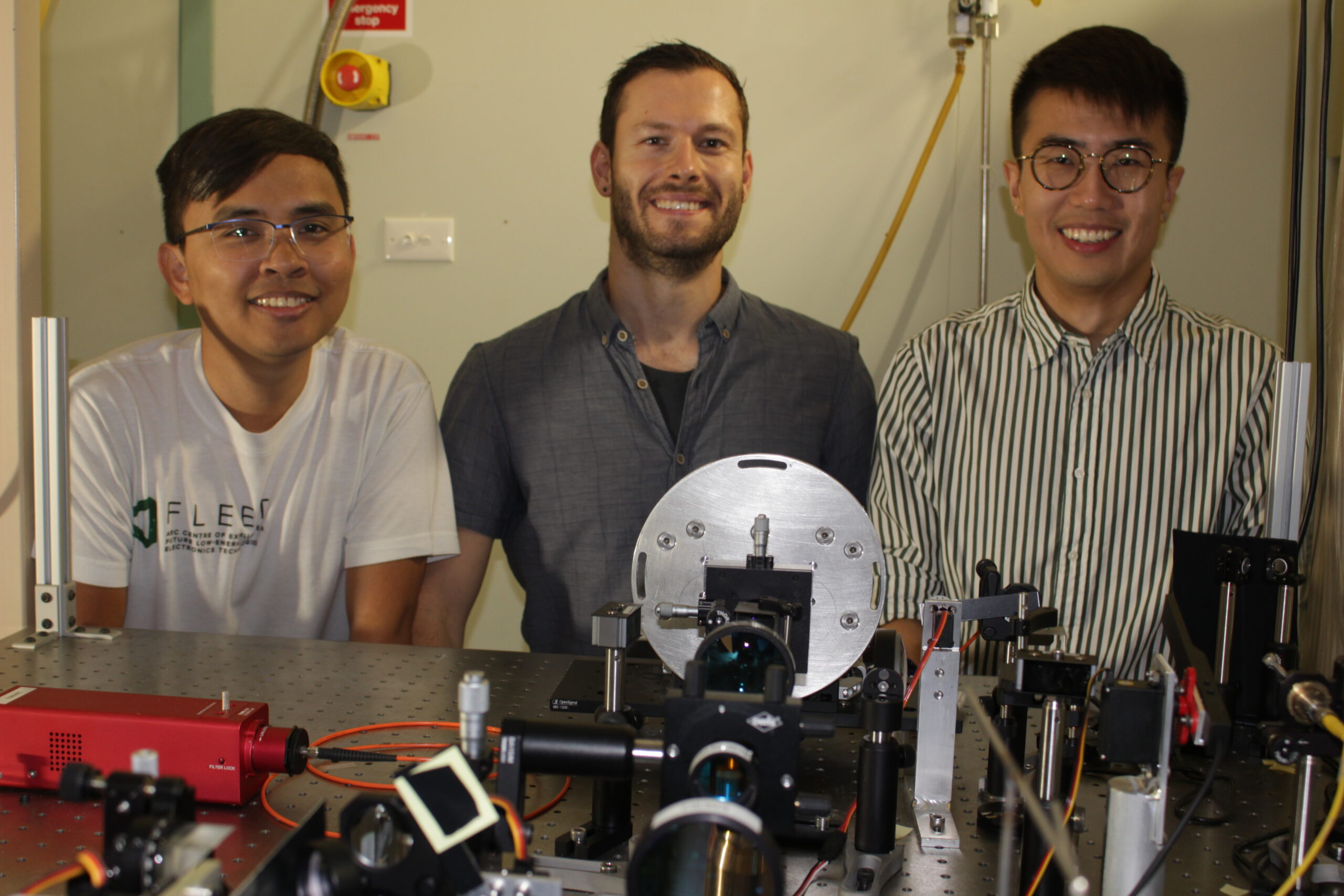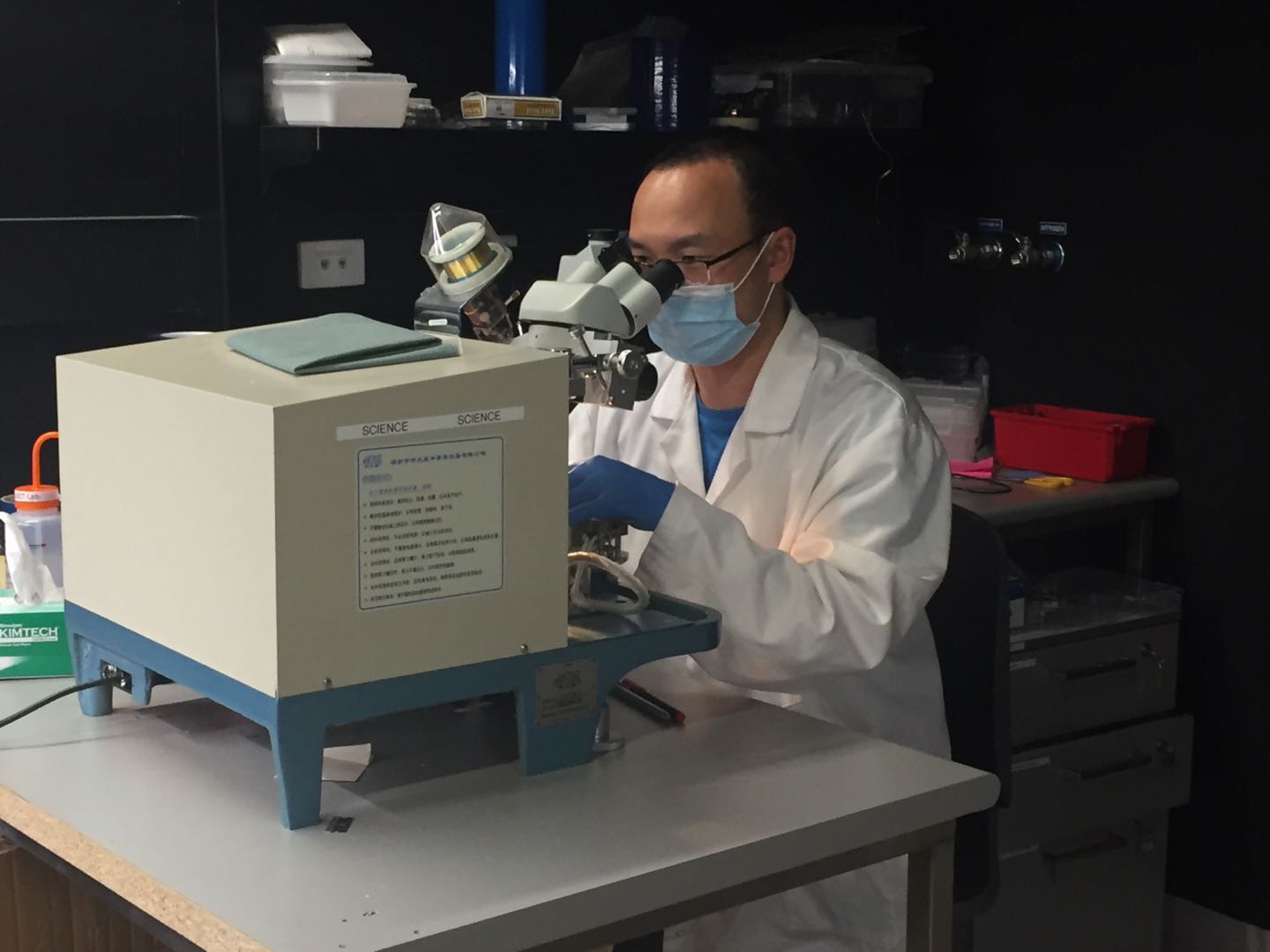Advancing quantum interaction understanding in 2D semiconductors

Unlocking fresh insights into the behaviour of quantum impurities within materials
An international theoretical study led by Monash University researchers introduced a novel approach known as ‘quantum virial expansion’ – a powerful tool to uncover the complex quantum interactions in 2D semiconductors.
This breakthrough holds potential to reshape our understanding of complex quantum systems and unlock exciting future applications utilising novel 2D materials.
The study of ‘quantum impurities’ has far-reaching applications across physics in systems as diverse as electrons in a crystal lattice and protons in neutron stars. These impurities can collectively form new quasi-particles with modified properties, essentially behaving as free particles.
The new technique shows remarkably good agreement with experimental results, essentially perfect at high temperature with small discrepancies at lower temperatures.
Although a straightforward many-body problem to state, quantum impurity problems are difficult to solve.
“The challenge lies in accurately describing the modified properties of the new quasi-particles,” says Dr Brendan Mulkerin (Monash), who led the collaboration with researchers in Spain.
The study offers a novel perspective on exciton-polarons as impurities in 2D materials – bound electron-hole pairs immersed in a fermionic medium.
As a solution to the problem, the Monash team introduced the ‘quantum virial expansion’ (QVE), a powerful method that has long been indispensable in ultra-cold quantum gases.
In this case, integrating QVE into the study of quantum impurities meant that only the interactions between pairs of quantum particles needed to be taken into account (i.e. rather than interactions between large numbers of particles). The resulting, solvable model sheds new light on the interplay between impurities and their surroundings in 2D semiconductors.

The new approach is remarkably effective at relatively high temperatures (e.g. in a semiconductor anything above a few degrees Kelvin) and low doping (where the electrons’ thermal wavelength is smaller than their interparticle spacing), leading to a ‘perturbatively’ exact theory (referring to a quantum system being perturbed from a simple, solvable limit).
“One of the most intriguing aspects of this research is its potential to unify different theoretical models, with the ongoing debate surrounding the appropriate model for explaining the optical response of 2D semiconductors being resolved through the quantum virial expansion,” says corresponding author A/Prof Jesper Levinsen (also at Monash).
The quantum virial expansion is expected to have a broad impact, extending its applications to various systems beyond 2D semiconductors.
“Understanding quantum impurity physics will continue to reveal insights and unlock novel properties and new possibilities for understanding, harnessing, and controlling quantum interactions,” says corresponding author Prof Meera Parish (Monash).
“Exact quantum virial expansion for the optical response of doped two-dimensional semiconductors” was published in Physical Review Letters in September 2023 (DOI: 10.1103/PhysRevLett.131.106901)
Hybrid particles surprise with negative mass

Unlocking counterintuitive exciton-polariton behaviours to probe new physics towards possible future quantum devices
A surprise observation of negative mass in exciton-polaritons has added yet another dimension of weirdness to these strange light–matter hybrid particles.
The experiments with exciton-polaritons carried out by Dr Matthias Wurdack, Dr Tinghe Yun and Dr Eliezer Estrecho, revealed that under certain conditions the dispersion became inverted – equating to a negative mass.
To add to the surprise, the unexpected cause has turned out to be losses.
“We did not expect that – the dispersion followed very unconventional behaviour,” said Matthias.
An exciton is formed from an electron and a hole pairing up in a semiconducting crystal. If this pair then strongly couples to a photon, a hybrid particle known as an exciton-polariton can form.
Exciton-polaritons were first observed more than 30 years ago and have been shown to exhibit remarkable properties, including superfluidity and formation of Bose-Einstein condensates. Around the world a number of research groups are exploring the counterintuitive behaviour of these strange particles in the hope they could underpin future low-energy technologies.
The observation of negative mass sent the scientists, from the group of Prof Elena Ostrovskaya, back to the whiteboard to try to work out what could cause such an effect.
The simplicity of the experiment, a monolayer of tungsten disulfide integrated in a microcavity, meant that it could be approximated with a simple coupled-oscillator model and so left few possibilities for unexpected effects. The team soon realised an imaginary coupling constant, called dissipative coupling, in their calculations replicated their observations.
However, they struggled to make sense of the mathematical model until they looked at other fields, such as microwave cavities, and realised that an imaginary coupling constant could equate to losses from the light–matter system.
To confirm that interpretation, the team reached out to experts in numerical modelling of physics in 2D systems at the Technical University of Berlin in Germany. These experts confirmed that the negative mass could arise from losses – specifically due to interactions between exciton-polaritons and phonons in the atomically-thin semiconductor.
Calculations also showed that, as the exciton-phonon interactions were turned off, the mass went from positive to negative, behaviour that subsequent experiments at ANU reproduced.
Matthias likened the behaviour of exciton-polaritons to that of boats on a lake.
“The phonons in the active material are like waves on the lake which can affect the movement of the boats – redirecting them, causing them to sway and capsize. This reduces their kinetic energies, which overall leads to losses in momentum, energy and occupation numbers,” he said.
In the quest for low-energy technology, scientists go to great lengths to reduce or remove losses, said Eliezer, also from FLEET.
“Typically, we don’t want losses, but here losses have given us something new,” he said.
“It enabled us to introduce a negative mass to the strongly-coupled system.”
The discovery is another facet of exciton-polaritons’ counterintuitive behaviour, Matthias said.
“This behaviour could be used for dispersion engineering, potentially to probe new physics and create as yet undreamed-of devices.”
“I cannot predict the extent of future applications yet using this kind of dispersion engineering, but I am hopeful this will be explored in future research activities,” he said.
Story first published: Australian National University
Negative-mass exciton polaritons induced by dissipative light-matter coupling in an atomically thin semiconductor was published in Nature Communications in February 2023 DOI 10.1038/s41467-023-36618-6
Destroying conductivity in a kagome metal

Electrically-controlled superconductor-to-‘failed insulator’ transition and giant anomalous Hall effect in the kagome metal CsV3Sb5
An RMIT-led international collaboration published in 2023 uncovered, for the first time, a distinct disorder-driven bosonic superconductor–insulator transition.
The discovery outlines a global picture of the giant anomalous Hall effect and reveals its correlation with the unconventional charge density wave in a recently discovered kagome superconductor metal family, with potential applications in future ultra-low-energy electronics.
Superconductors, which can transmit electricity without energy dissipation, hold great promise for the development of future low-energy electronics technologies. They are already applied in diverse fields such as hover trains and medical magnetic resonance imaging (MRI) machines.
However, precisely how the superconductivity forms and works in many materials remains an unsolved issue and limits its applications. FLEET Research Fellow Dr Guolin Zheng (RMIT). “We wanted to see if we could achieve similar success as our trials using the proton gate technique in vdW spintronic devices, which effectively modulated similar carrier densities,” says first author, FLEET Research Fellow Dr Guolin Zheng (RMIT).
Recently, a new kagome superconductor family termed AV3Sb5has attracted intensive interest for their novel properties. (‘Kagome’ materials feature an unusual lattice named for a Japanese basket-weave pattern with corner-sharing triangles, and the A in AV3Sb5 refers to caesium, rubidium, or potassium.)
Although quantum phenomena accessible in AV3Sb5 materials provide ideal platforms for physics studies such as topology and strong correlations, the origin of these material’s giant anomalous Hall effect and superconductivity have remained unexplained, despite many recent investigations.

The FLEET-led collaboration of researchers at RMIT University and partner organisation the High Magnetic Field Laboratory (China) confirmed for the first time the electric control of superconductivity and anomalous Hall effect (AHE) in the van der Waals (vdW) kagome metal CsV3Sb5.
The key was manipulating the giant AHE via reversible proton intercalation.
“We wanted to see if we could achieve similar success as our trials using the proton gate technique in vdW spintronic devices, which effectively modulated similar carrier densities,” says first author, FLEET Research Fellow Dr Guolin Zheng (RMIT).
“The ability to tune the carrier density and the corresponding Fermi surfaces would play a vital role in understanding and manipulating these novel quantum states and would potentially realise some exotic quantum phase transitions.”
The team chose to test this theory on CsV3Sb5devices, easily designed and fabricated based on the FLEET team’s rich experience in this field. With thinner flakes, around 40 nanometres, the injection of the proton became quite easy, as well as being highly reversible. “Indeed, we have seldom met such a proton-friendly material!” says co-first author, FLEET Research Fellow Dr Cheng Tan (RMIT).
The unique coexistence of electronic correlations and band topology in AV3Sb5 materials allows investigation of intriguing transitions of these correlated states, such as superconductor-to-insulator transition, a quantum phase transition usually tuned by disorders, magnetic fields and electric gating.
The team’s further explorations of these potential quantum phase transitions met with success, but they were surprised to observe that the critical temperature of the phase shift decreased, showing a clear superconductor-to-insulator transition under increasing proton injection.

“Proton intercalation introduced disorder and suppressed both charge density wave and superconducting phase coherence,” says contributing-author A/Prof Lan Wang (also at RMIT). “And this gave rise to a superconductor–insulator transition associated with localised Cooper pairs and higher electrical resistance, dubbed a ‘failed insulator’”.
This discovery of a distinct, disorder-driven bosonic superconductor–insulator transition outlines a global picture of giant AHE and reveals its correlation with the well-known unconventional charge density wave in the CsV3Sb5 family. “This significant and electrically-controlled superconductor–insulator transition and anomalous Hall effect in kagome metals should inspire more investigations of the relevant intriguing physics, with promise for energy-saving nanoelectronic devices,” says Lan.
** “Electrically controlled superconductor-tofailed insulator transition and giant anomalous Hall effect in kagome metal CsV3Sb5 nanoflakes” was published in Nature Communications in February 2023. (DOI: 10.1038/s41467-023-36208-6)


